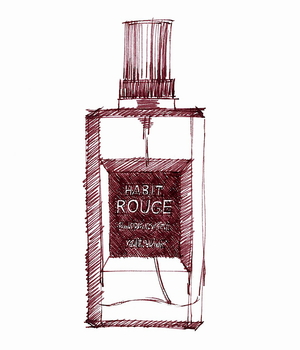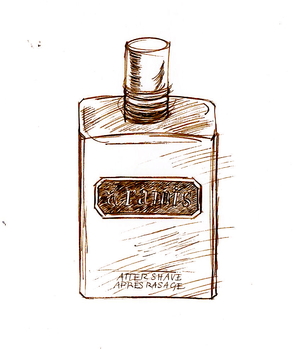Tagged With ‘1965’
Guerlain
Habit Rouge
27 April, 2015
 ‘Mass luxury’ may be the oxymoron of the moment, but the name of Habit Rouge is a nod back to a time when perfume really was a luxury enjoyed only by the stinking rich (eg the family Guerlain), among whom fox-hunting was a favourite pursuit.
‘Mass luxury’ may be the oxymoron of the moment, but the name of Habit Rouge is a nod back to a time when perfume really was a luxury enjoyed only by the stinking rich (eg the family Guerlain), among whom fox-hunting was a favourite pursuit.
Habit Rouge, in this context, is the French term for what British toffs call (with typical bourgeois-baiting mystification) ‘hunting pinks’, the scarlet riding jackets worn while hunting the fox. But that’s as far as the hunting or riding references go, which is probably a good thing, if you know what an actual fox or a horse-stable smells like.
Created by the last of the great Guerlain family perfumers, Jean-Paul, and launched in 1965, Habit Rouge was only the third Guerlain fragrance to be aimed at men. In character it is very different from its immediate predecessor, Vetiver, launched in 1959. While Vetiver is elegantly earthy (a brilliant contradiction in terms) and ineffably masculine, Habit Rouge is much more dandified, with a sharp, powdery sweetness that some people love but that makes others gag – imagine lemon sherbert in liquid form and you won’t be far wrong.
According to my friend the perfumer Roja Dove (who worked at Guerlain for twenty years), it ‘has an extraordinary volume of hesperidic materials, especially bergamot and lemon, which make up in excess of 25 per cent of the formula. Without question you can “feel” their effervescence.’It’s so zingy to start with that I wonder whether it might even contain a touch of aldehydes – the chemicals that give Chanel No. 5 its champagne fizz.
With all that lemon you’d imagine it would smell like an eau de cologne, but like other classic Guerlain perfumes Habit Rouge has great depth and complexity, and in the terminology of the perfume world it actually counts as an ‘oriental’-style fragrance, as behind the sherbert there’s a surprising amount of spice as well.
Though the version we have today was apparently ‘cleaned up’, as the industry jargon has it, by another fine perfumer, Edouard Fléchier, to comply with updated regulations governing the use of potentially harmful ingredients, it still smells wonderfully rich, with traces of vanilla and patchouli for those who smell it carefully.
Habit Rouge also lasts and lasts, which for me is an added plus when a perfume is as great as this – for anyone on a limited budget it’s hard to justify spending £70 or so on something that vanishes within an hour of putting it on. Definitely worth hunting down.
Aramis
Aramis
13 September, 2014
 Snobbery seeps into most areas of life, including perfume, and it’s never a very attractive trait, though it’s something that most of us have been afflicted by at one time or another – at least until we learn better.
Snobbery seeps into most areas of life, including perfume, and it’s never a very attractive trait, though it’s something that most of us have been afflicted by at one time or another – at least until we learn better.
As our knowledge of perfume grows, a lot of us get a bit embarrassed about the mass-market fragrances we might once have liked. In some cases that’s fair enough: I don’t imagine that, if I went back and smelled the M&S aftershave I was given for a teenage birthday, I would think ‘wow, what a fantastic example of the perfumer’s art’. On the other hand, by turning our backs on popular perfumes we risk throwing out the Brut with the bathwater.
Aramis illustrates this danger very well. It might have been around as long as anyone can remember. It might (at least until fairly recently) have been as cheap as chips. It might not have come in the most stylish bottle, or the most alluring packaging. Yet it’s actually a wonderful, sexy, high-quality fragrance, which deserves its place on any perfume-lover’s (cool, dark) shelf.
Aramis was launched in 1964, the same year as the original Brut for Men. The first perfume in Estée Lauder’s all-male range of fragrances and skincare, it came to Britain in 1965, and at first was sold exclusively in Harrods – which just shows you images can change.
It was created by one of the finest perfumers of the time, Bernard Chant, who worked for the perfume multinational, International Flavors and Fragrances (IFF), and died in 1987. Chant made his name with the women’s perfume, Cabochard, which was launched in 1959. Combining the dry, leathery smell of isobutyl quinolene with bitter orange, jasmine, ylang-ylang, and various kinds of spice, it was a powerful, confident scent, and quickly became a best-seller – though it has been repeatedly reformulated since, so today’s Cabochard bears little or no resemblance to the original.
I mention Cabochard at some length because, when Chant came to create Aramis for Men, it seems he simply (as far as anything is simple in perfumery) adapted the formula for Cabochard, taking some of the floweriness out and emphasising its leathery-woodiness. The result is an equally punchy fragrance with lots of depth, but just enough rough-edged masculinity (including the sharp spicy-sweaty smell of cumin) to make it appealing to the stubbliest of men.
Aramis is spicy, sweet and long-lasting, and though its spiciness initially made me think of Chanel’s Egoïste, a quick comparison reveals that the latter is much more floral, with a strong dose of vanilla that Aramis lacks. If it doesn’t smell as unusual as some of the men’s perfumes I love, that’s as much as anything to do that it has been around for so long that we’ve since smelled lots of cheap copies, making it seem less original than it actually was in its time.
Bernard Chant went on to create a number of other fine perfumes for Estée Lauder’s various brands, including Azurée (1969) and the well-known Aromatics Elixir (1971), as well as the men’s fragrances Aramis 900 (1973, reviewed here), Devin (1978) and JHL (1981), which were repackaged and relaunched in 2009. They’re all worth exploring, and there’s nothing about them to be snobbish about.